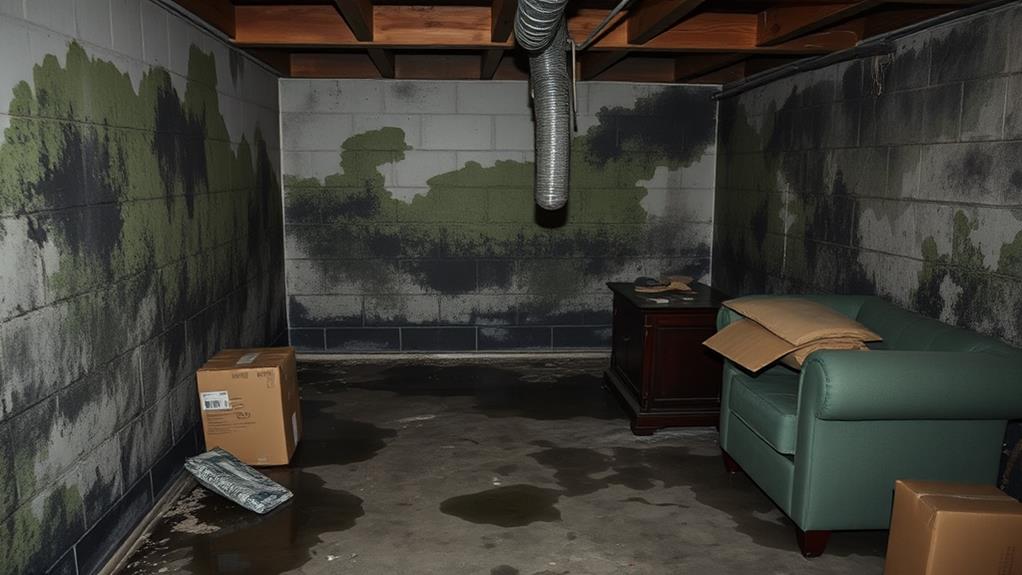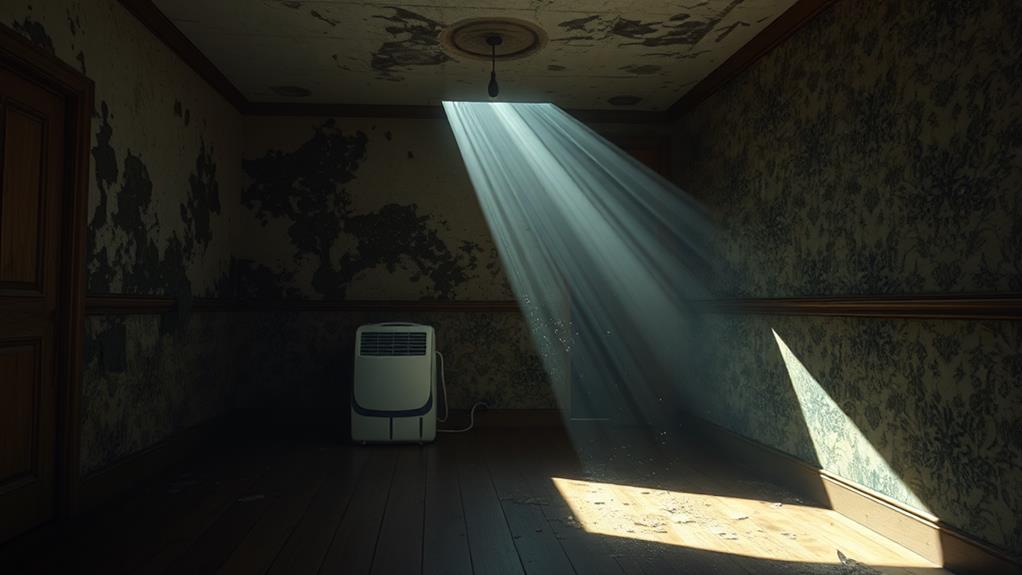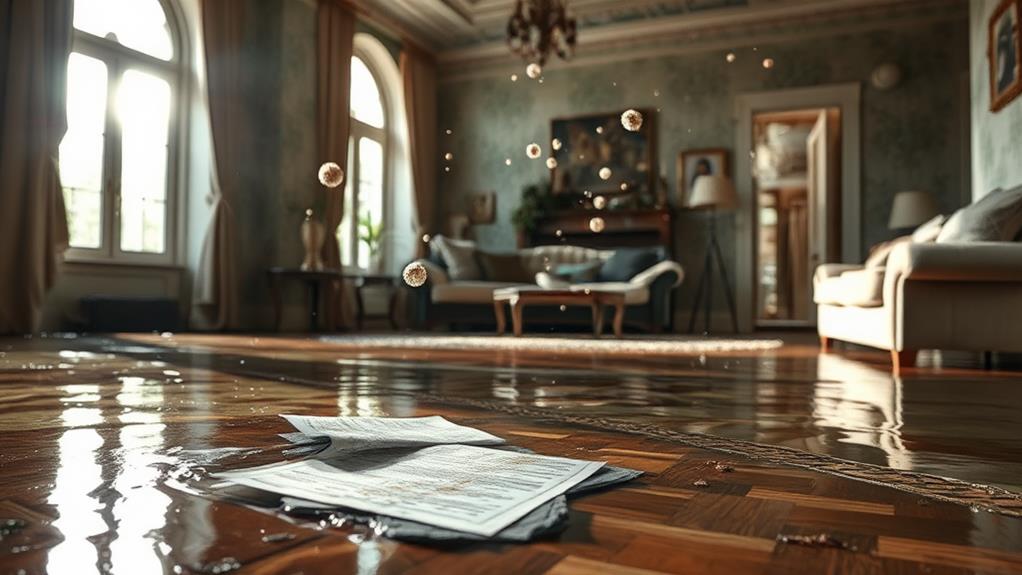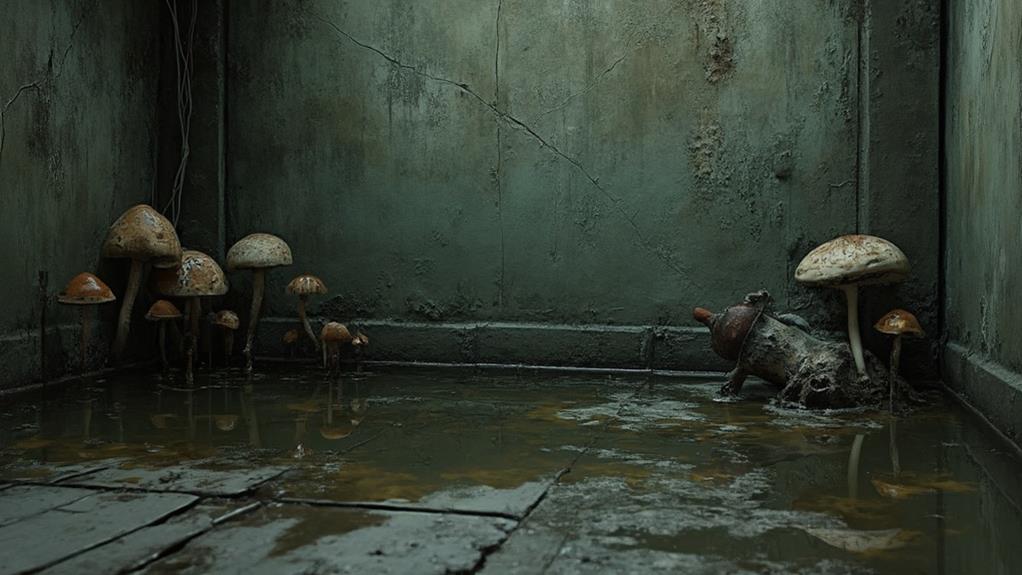Ignoring standing water in your home can have severe long-term consequences. Mold growth poses significant health risks, causing respiratory issues and allergies. Structural damage compromises the integrity of building materials, leading to wood rot, metal corrosion, and foundation problems. Electrical systems face hazards, increasing the risk of short circuits and fire. Pest infestations become more likely, bringing additional health concerns. Indoor air quality deteriorates, exacerbating respiratory conditions. Property value depreciates as visible damage and structural issues become apparent. These compounding effects can result in extensive, costly repairs and potential health complications. Understanding the full scope of these impacts is crucial for homeowners facing water-related issues.
Mold Growth and Health Risks

The presence of standing water creates an ideal environment for mold growth, posing significant health risks to occupants. Mold spores thrive in damp conditions, rapidly colonizing wet surfaces within 24 to 48 hours. As mold spreads, it releases microscopic spores into the air, which can be inhaled by individuals in the affected area.
Exposure to mold can lead to various health issues, particularly for those with respiratory conditions, allergies, or weakened immune systems. Common symptoms include coughing, wheezing, nasal congestion, eye irritation, and skin rashes. In more severe cases, prolonged exposure may result in chronic lung illnesses or exacerbate existing respiratory problems such as asthma.
Certain types of mold, like Stachybotrys chartarum (black mold), produce mycotoxins that can cause more serious health effects, including neurological symptoms and immune system suppression. Ignoring standing water not only allows mold to proliferate but also increases the likelihood of encountering these toxic varieties. To prevent mold growth and associated health risks, it is crucial to address standing water issues promptly and thoroughly dry affected areas within 48 hours.
Structural Damage to Your Home
Negligence in addressing standing water can lead to severe structural damage in your home. Water infiltration compromises the integrity of building materials, causing wood to rot, metal to corrode, and concrete to deteriorate. Prolonged exposure to moisture weakens load-bearing elements, potentially leading to sagging floors, warped walls, and even partial collapse of the structure.
Foundation damage is a particularly severe consequence of standing water. As water seeps into the soil surrounding your home, it can cause the foundation to shift, crack, or settle unevenly. This movement can result in visible signs such as cracks in walls, uneven floors, and doors that no longer close properly. Additionally, water can penetrate basement walls, leading to efflorescence, spalling, and eventual structural failure.
Ignoring standing water also affects the home's electrical system. Water can corrode wiring, short-circuit outlets, and damage electrical panels, creating fire hazards and necessitating costly repairs. Furthermore, standing water can compromise the effectiveness of insulation, leading to increased energy costs and reduced comfort. Addressing water issues promptly is crucial to preserving your home's structural integrity and value.
Electrical System Hazards

Standing water poses significant threats to your home's electrical system, creating dangerous hazards that can compromise safety and lead to costly repairs. When water comes into contact with electrical components, it can cause short circuits, corrosion, and electrical fires. Outlets, switches, and wiring exposed to moisture are particularly vulnerable, potentially leading to system failures or electrocution risks.
Prolonged exposure to standing water can damage insulation on wires, increasing the likelihood of electrical malfunctions. This deterioration may not be immediately apparent, presenting hidden dangers long after the water has receded. Additionally, water can infiltrate junction boxes, circuit breakers, and electrical panels, causing rust and compromising their functionality.
The presence of standing water also raises the risk of electrical shock for occupants. Even if the main power supply is shut off, residual current in waterlogged systems can pose hazards. Furthermore, appliances and electronic devices exposed to water may become permanently damaged or unsafe to use. To mitigate these risks, it's crucial to have a professional electrician inspect and assess your electrical system after any significant water exposure, ensuring all components are safe and functional before restoring power.
Pest Infestations
Ignoring standing water can create an ideal environment for pest infestations, turning your home into a haven for unwanted creatures. Mosquitoes, in particular, thrive in stagnant water, using it as breeding grounds to lay their eggs. These disease-carrying insects can quickly multiply, posing health risks to you and your family.
Other pests attracted to damp environments include cockroaches, silverfish, and various types of beetles. These insects seek out moisture and can damage belongings, contaminate food sources, and spread harmful bacteria throughout your home. Rodents like rats and mice are also drawn to areas with standing water, as it provides them with a readily available drinking source.
As the pest population grows, so does the potential for structural damage. Termites and carpenter ants, both moisture-loving insects, can infiltrate water-damaged wood, compromising the integrity of your home's framework. Additionally, the presence of these pests can trigger allergies and respiratory issues in occupants, further compromising your family's health and well-being. Addressing standing water promptly is crucial to prevent these infestations and maintain a safe, healthy living environment.
Indoor Air Quality Deterioration

The air quality within your home can rapidly deteriorate when standing water is left unaddressed. As moisture accumulates, it creates an ideal environment for mold and mildew growth, which release spores into the air. These microscopic particles can trigger allergic reactions, respiratory issues, and other health problems in occupants.
Standing water also increases humidity levels, leading to a damp, musty odor that permeates the house. This excessive moisture can cause wood to warp, paint to peel, and wallpaper to separate from walls, further compromising indoor air quality as these materials release volatile organic compounds (VOCs).
The presence of stagnant water often attracts insects and pests, whose droppings and shed body parts become airborne contaminants. Additionally, bacteria thriving in standing water can release harmful toxins into the air, potentially causing serious health issues.
Over time, the combination of mold, bacteria, and increased humidity can create a toxic indoor environment. This can exacerbate existing respiratory conditions, such as asthma, and may lead to the development of new health problems in otherwise healthy individuals. Addressing standing water promptly is crucial to maintaining good indoor air quality and protecting the health of your home's occupants.
Property Value Depreciation
Beyond the health implications of poor indoor air quality, unaddressed standing water can significantly impact a property's market value. Homes with persistent moisture issues often experience substantial depreciation, as potential buyers are wary of the long-term consequences and remediation costs associated with water damage.
The presence of standing water can lead to visible signs of deterioration, such as warped floors, peeling paint, and stained walls. These aesthetic issues alone can reduce a property's appeal and perceived value. Moreover, the structural integrity of the building may be compromised, with water damage affecting foundations, support beams, and load-bearing walls. Such damage can result in costly repairs and renovations, further diminishing the property's worth.
Real estate appraisers and inspectors are trained to identify signs of water damage and moisture problems. Their assessments can significantly influence a property's valuation, potentially leading to lower offers from prospective buyers or difficulties in securing favorable mortgage terms. In severe cases, properties with extensive water damage may become unsellable without substantial investments in restoration and mold remediation, effectively rendering the property a financial liability rather than an asset.
Insurance Claim Complications

Numerous insurance claim complications can arise when homeowners neglect standing water issues on their property. Insurance providers often require prompt reporting and mitigation of water damage to maintain coverage. Failing to address standing water promptly may result in claim denials or reduced payouts, as insurers may argue that the damage was exacerbated by the homeowner's negligence.
Moreover, many policies have specific exclusions for long-term water exposure or gradual damage. If standing water leads to mold growth, structural deterioration, or foundation issues over time, these problems may not be covered under standard homeowners insurance policies. Some insurers may even cancel or refuse to renew policies for properties with a history of unresolved water issues.
Additionally, when filing a claim for water damage, insurers typically investigate the cause and duration of the problem. If they determine that the homeowner knew about the standing water but failed to take action, they may dispute the claim or reduce the settlement amount. This can lead to protracted negotiations, potential legal disputes, and significant out-of-pocket expenses for the homeowner.
Frequently Asked Questions
How Quickly Can Standing Water Cause Damage to My Home?
Standing water can cause damage to your home within hours. Initial effects include staining and warping of materials. Mold growth can begin in 24-48 hours. Structural damage and electrical hazards may manifest within days if left unaddressed.
Can I Remove Standing Water Myself, or Should I Hire Professionals?
Like a ticking time bomb, standing water demands swift action. While you can remove small amounts yourself using pumps or wet vacuums, extensive water damage requires professional expertise to prevent mold growth and structural issues. Consider the severity before deciding.
Are There Any Immediate Signs of Water Damage I Should Look For?
Immediate signs of water damage include water stains on walls or ceilings, warped or bubbling surfaces, musty odors, and visible mold growth. Also, look for peeling paint, swollen wood, and damp carpets or flooring in affected areas.
What Should I Do With Water-Damaged Personal Belongings and Furniture?
Did you know? 25% of water-damaged items can be salvaged if treated within 48 hours. For water-damaged belongings and furniture, quickly remove them from wet areas, dry thoroughly, and consult professionals for specialized restoration techniques to prevent mold growth.
How Long Does It Take for a Home to Fully Recover From Water Damage?
The recovery time for a home after water damage varies depending on the extent of damage and restoration efforts. Generally, it can take anywhere from a few days to several months for complete drying, repairs, and restoration to be completed.
Conclusion
Ignoring standing water in a home can lead to catastrophic consequences. The cascading effects include rampant mold growth, structural deterioration, electrical hazards, and pest invasions. Indoor air quality plummets, creating an environment so toxic it could rival a hazardous waste site. Property values nosedive, and insurance claims become increasingly complex. Ultimately, neglecting water damage transforms a once-safe haven into a perilous, uninhabitable structure. Swift action is imperative to mitigate these long-term, devastating impacts and preserve the integrity of the dwelling.

